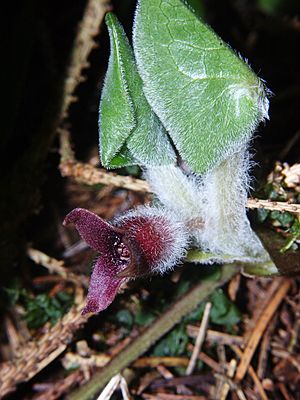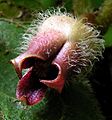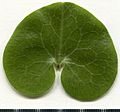European wild ginger facts for kids
Quick facts for kids European wild ginger |
|
|---|---|
 |
|
| Flower and new leaves from a plant in the Schwäbisch-Fränkischer Forest in Germany | |
| Scientific classification | |
| Genus: |
Asarum
|
| Species: |
europaeum
|
Asarum europaeum, also known as European wild ginger, is a cool plant found in many parts of Europe. It's a type of flowering plant in the birthwort family. Even though it's called "wild ginger" because its roots smell a bit like ginger, it's actually not related to the ginger you use for cooking! That kind of ginger comes from tropical places in Asia.
European wild ginger is a plant that creeps along the ground. It stays green all year round and comes back every year. It has shiny, kidney-shaped leaves and small, dull purple flowers. These flowers are often hidden under the leaves. People sometimes use this plant as a spice or for flavor. A long time ago, it was even used in old medicines.
Contents
What It Looks Like
The stems of European wild ginger lie flat on the ground and are about 10 to 15 centimeters (4 to 6 inches) long. Each stem has two kidney-shaped leaves with long stems of their own. The leaves are about 10 centimeters (4 inches) wide. The top of the leaves is shiny, and they have a smell and taste like pepper.
The flowers grow one by one at the end of the stems and hang downwards. The flower tube is made of parts that are joined together. It ends with three parts that look like petals. These parts are brownish at the ends and dark purple in the middle. The plant has 12 stamens, which are the parts that make pollen. The flowers appear in late winter and spring.
Where It Grows Naturally
European wild ginger grows in many places across Europe. You can find it from southern Finland and northern Russia all the way south to countries like France, Italy, and Bulgaria. It doesn't grow naturally in the British Isles (like the UK) or in Scandinavia (like Sweden and Norway). It's also not found in northwestern Germany or the Netherlands. However, people do grow it in gardens in the United Kingdom, Denmark, Sweden, Norway, and the Netherlands.
This plant usually grows in forests where trees lose their leaves in autumn (deciduous woodlands) or in forests with cone-bearing trees (coniferous forests). It especially likes chalky soils, which are soils rich in calcium.
Different Kinds of European Wild Ginger
Scientists have found two main types, or subspecies, of European wild ginger besides the most common one.
- One type is called A. europaeum ssp. caucasicum. This one is only found in the southwestern Alps mountains.
- The other type is A. europaeum ssp. italicum. You can find this one in central and northern Italy, as well as in some mountains in North Macedonia and Kosovo.
How People Grow It
European wild ginger can grow well even in shady places where other plants might struggle. Because of this, it's often planted in gardens to cover the ground. This plant is so good at growing that it has won an award called the Royal Horticultural Society's Award of Garden Merit. This award means it's an excellent plant for gardeners to grow.
Images for kids
See also
 In Spanish: Ásaro para niños
In Spanish: Ásaro para niños







